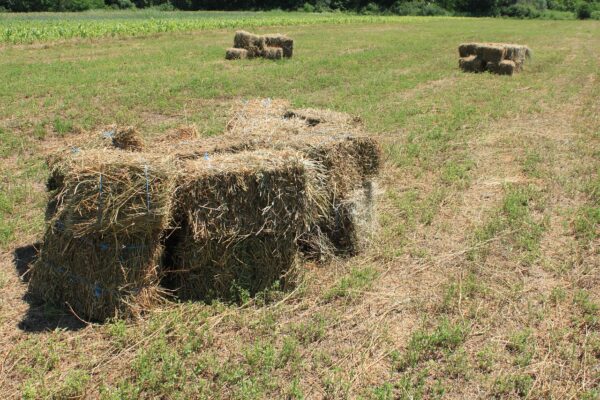Alfalfa has a long history of using up water and feeding cows in the West. It is a tough plant, but most people do not know what it is and why it is so good for Southern Utah.
According to an article published in the Salt Lake Tribune, there are 9,300 hay-growing operations in Utah, producing 2.4 million tons of alfalfa each year. Many are our next-door neighbors in Piute, Wayne, and Garfield counties.
The alfalfa plant is a perennial legume that can grow pretty much anywhere. It is very green and leafy, with purple, nectar-rich flowers and deep roots. Farmers grow alfalfa because it uses water efficiently, is good for cows, and creates strong ecosystems, but the crop and its Utah growers can be greatly misunderstood.
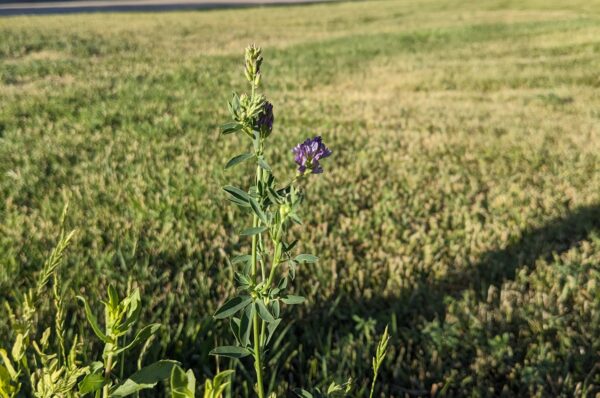
Alfalfa’s History of Water Consumption in the West
A lot of the misunderstandings around alfalfa come from concerns about droughts in the West. In the news alfalfa can be painted as an over-thirsty, nonessential cash crop that is drying up the Colorado River.
“We need to address agriculture straight on,” Amanda Starbuck, research director of Food & Water Watch, told the Guardian. “Alfalfa is one of the major crops that is being grown with this water. And it is unfortunately one of the most water-thirsty.”
Even some farmers are choosing to leave the crop behind because it takes so much water, soaking up as high as 5 feet per acre. That is a lot of water compared to what sugar beets (3 feet an acre), and dry beans (1.5 feet each acre) use. And that makes a difference for farmers when the water is running out.
“I’ve seen how dry everything is,” said Stephen Hawk, a fourth-generation farmer in California’s Imperial Valley. “One day, there’s not going to be enough water … Our ground is worthless if we don’t have the water to farm it.”
But some farmers take a different point of view.
Trevor Tagg, who runs a 3,000-acre farm also in Imperial Valley, told the Guardian he was frustrated by the point of view that people do not need alfalfa. “Our country is so disconnected from our food supply chain,” said Tagg. “People don’t know what alfalfa is or what it’s even used for. So it’s very easy to say, ‘Oh, we don’t eat that. So get rid of it’.”
And it’s true that alfalfa uses a lot of water — for Utah it’s 68% of our water — but most agriculture experts say that’s not the whole picture. And there would be consequences for just “getting rid of it.”

Why Farmers Grow Alfalfa
So why do farmers grow so much alfalfa in drought-stricken Southern Utah? The answer is that, granted it uses a lot of water, it is the most water-efficient crop there is. It has many advantages for water use, dairy production, and the creation of healthy soils and ecosystems.
Water Use
Take the alfalfa roots, for example. Pulling one of those things out of your yard is pretty much impossible. That’s because alfalfa roots reach 15-20 feet in the ground. That may be annoying to gardeners, but it’s great news for farmers and ranchers.
Between its deep roots, and the fact that farmers can cut and harvest alfalfa multiple times per year, alfalfa really does a good job of giving the highest yield for the water it uses. Because of this, according to research done at the University of California, alfalfa actually has greater water use efficiency than many other crops.
Of the water that it doesn’t use, alfalfa also provides valuable infiltration in the soil, according to one state official. Tony Richards, head of the Utah Department of Agriculture and Food’s (UDAF) soil health program, says alfalfa can help the soil make better use of the rainwater.
“If we do have a 1-inch rainstorm, are you able to infiltrate all of that inch or is it leaving your field, going somewhere else and taking soil with it as usually is the case?” said Richards. “That infiltration is critical because that water that goes down deep, it also recharges the aquifer. It’s what creates our springs.”
The deep roots on alfalfa help keep the water in the field, either through the alfalfa using it or letting it filter into the soil, rather than losing it to runoff.
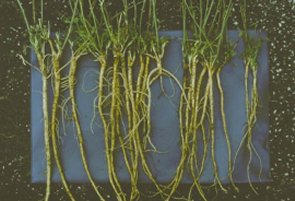
Dairy Production
Alfalfa is also an extremely healthy forage for the dairy cows in the West, which according to Utah State University, provide “nearly 50% of the nation’s milk supply.”
Sanpete County rancher Stan Jensen said alfalfa is “a universal feed for cows, horses, goats, anything, and it has the protein that a lot of animals can accept and do really well on.” He added, “I don’t know of another crop around here that would bring in the yield and the income and serve as many purposes as alfalfa.”
Dairy cows need a lot of protein to produce as much milk as they do. Alfalfa is these cows’ main source of protein, which helps them make a lot of milk, and fiber, which helps prevent ulcers and abscesses.
Alfalfa is great for grazing, but it also makes very healthy hay. Dry hay bales can store for a long time and feed cows throughout the winter and during lapses in public lands leases. Without alfalfa, cows would be missing an essential part of their diet, and it would have consequences in the dairy industry.
Creation of Healthy Soils and Ecosystems
Unlike many other crops, like corn and soybean, alfalfa can actually be very healthy for the soil. Through a symbiotic relationship with bacteria, it is able to produce enough nitrogen that it does not require fertilizer to grow. Its roots actually help replenish nitrogen and CO2 in the soil, benefitting other crops in rotation and helping to regulate the climate.
In addition to alfalfa’s benefits for other crops and the air, it also helps animal ecosystems thrive. Its flowers are full of good nectar for bees in the area. And the habitat it provides attracts animals from across the food chain, from insects and mice, to deer and other large game, to predators like eagles, hawks and cougars.
Alfalfa helps create ideal conditions not just for ranchers, but also for hunters, beekeepers, birdwatchers, and neighboring farmers.
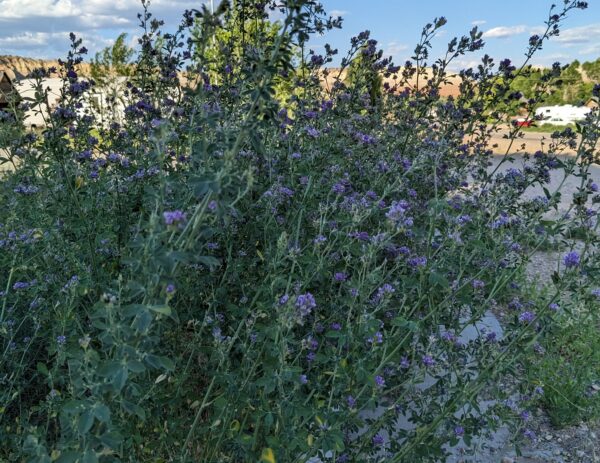
Why We Should Continue Growing Alfalfa
Although alfalfa uses a lot of water, it has a long history of working really well in the drought-stricken West. So far, it is the most water-efficient crop out there, its leafy, protein-rich greens remain the healthiest forage for dairy cows and livestock, and its roots, flowers and forage can actually be very beneficial for the environment.
USU calls alfalfa “a critical component of sustainable agricultural systems for the future.” Luckily Southern Utah is the perfect place for a healthy alfalfa farm, and hopefully it sticks around for generations to come.
– by Abbie Call
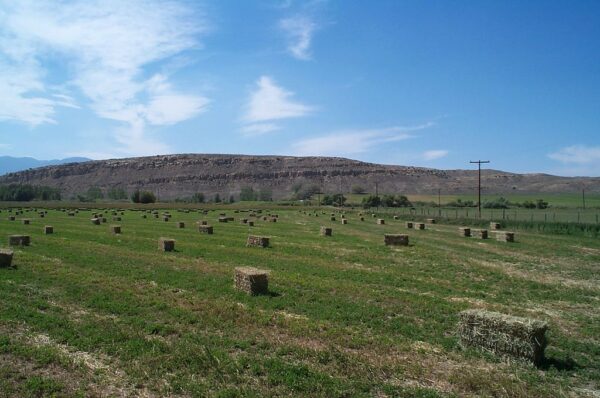
Feature image caption: Square hay bales dry in a Nevada field. Alfalfa’s water efficiency and health benefits for dairy cows make it a great crop to grow in the West. Courtesy Pixabay.

Abbie Call – Cannonville/Kirksville, Missouri
Abbie Call is a journalist and editor at The Byway. She graduated in 2022 with a bachelor’s degree in editing and publishing from Brigham Young University. Her favorite topics to write about include anything local, Utah’s megadrought, and mental health and meaning in life. In her free time, she enjoys reading, hanging out with family, quilting and hiking.
Find Abbie on Threads @abbieb.call or contact her at [email protected].

